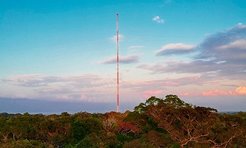ATTO celebrates its anniversary

The Amazon Tall Tower Observatory (ATTO) is located in the middle of the Amazon basin of Brazil, about 150 km northeast of Manaus. In this remote region, scientists from German and Brazilian research institutions are jointly studying the interactions between the rainforest and the atmosphere. The heart of the research station is a steel tower with a height of 325 meters. This makes the ATTO tall tower as high as the Eiffel Tower in Paris and, as the tallest research tower in South America, extending well above the canopy of the forest.
Scientists at the Max Planck Institutes for Chemistry in Mainz and for Biogeochemistry in Jena were already dreaming of a research station in the Amazon at the end of the 1990s. Already back then they were aware how important this rainforest is for global climate, but lacked continuous long-term observations that are precise enough to link to global networks monitoring climate and atmosphere. Many years passed before the initial idea became reality, but in 2010 the time had come. In cooperation with the National Institute of Amazonian Research (INPA) in Manaus, the researchers set up the first infrastructure. An 80-metre high tower and a mast of the same height were built, which were used to carry out the first atmospheric measurements. They form the basis for continuous and long-term observation connecting the central Amazon forest to the atmosphere and global climate.
Since then, the German-Brazilian research station has grown continually. More than 200 scientists from universities and research institutions in various countries are involved: biologists, ecologists, meteorologists, chemists, and atmospheric physicists work on complex, climate-relevant issues in an interdisciplinary way. New instruments developed, adapted or optimized for the use under the harsh climatic conditions of the tropical rainforest. Some studies provide information about local processes influenced by the composition of plant species and geographical conditions, among other things. In addition, for the past five years, the tall tower has allowed researchers to collect atmospheric data that is influenced by an area of several 100 km2 of rainforest. In combination with the knowledge of local processes, this enables the scientists to investigate large-scale relationships between the rainforest and the changing climate.
In the first 5 to10 years of this long-term project, the team already made a multitude of discoveries. For example, we learned that 60% of the rainfall that falls over the Amazon is recycled back to the atmosphere, most of it via transpiration by the larger trees. But to re-form clouds, cloud condensation nuclei are needed. The pristine atmosphere around ATTO in the wet season contains very few aerosols, such as pollutants. Instead, organic gases emitted by the tree canopy to the upper atmosphere play an important role. Through chemical reactions they form particles in the atmosphere that than influence cloud properties and precipitation. Such gases include volatile organic compounds (VOCs). Even though the Amazon makes up only 4 % of the land surface, 25 to 40% of global VOC emissions come from the Amazon region, but their composition changes with an increase in drought stress.
To celebrate the ATTO anniversaries, we are creating a special blog on the ATTO website www.attoproject.org. In 12 chapters, project members will report on the development of the research station from their point of view in the coming weeks. In the first chapter, which was published today, Prof. Meinrat Andreae, talks about the pipe dream with which it all began and how the German Federal Ministry of Education and Research (BMBF) and its Brazilian counterpart (Ministério da Ciência, Tecnologia e Inovações, MCTI) were convinced to provide funding to build the tall tower. Further chapters include the adventurous expeditions into the Amazon to identify the future ATTO location, the struggle with the adverse climatic conditions and finally the mammoth project to build a steel colossus far away from any civilization in the middle of the rainforest. These reminiscences are brought to life by many photos and videos, and end with a glimpse into the future.
The Amazon Tall Tower Observatory is a German-Brazilian cooperation project. It is managed by the Max Planck Institutes for Biogeochemistry in Jena and for Chemistry in Mainz, as well as by the Brazilian INPA and the Amazon State University (UEA) in Manaus. The project is funded by the German Federal Ministry of Education and Research (BMBF), the Ministério da Ciência, Tecnologia e Inovações (MCTI), the Max Planck Society and the Brazilian organizations including FAPEAM and individual researchers bring funding from other scientific funding agencies.
Further information about the project, the participating institutions and researchers, the research fields and scientific findings can be found at attoproject.org. Project news and an insight into the work and life of the scientists can also be found on the social media channels on Facebook, Twitter and Instagram. Please contact Iris Moebius with any question (iris.moebius@bgc-jena.mpg.de or +49 3641 576371)
